An In-depth Analysis of IPv6 Addressing Types and Implementation
VerifiedAdded on 2021/02/20
|9
|1932
|57
Report
AI Summary
This report provides a comprehensive overview of IPv6 addressing, a crucial component of modern network systems. It begins with an introduction to the Internet Protocol and its evolution, setting the stage for an in-depth examination of IPv6 addressing. The report details various IPv6 address types, including global unicast, unique local, and link-local addresses, providing clear explanations and illustrative examples. It explores the structure and format of IPv6 addresses, highlighting the differences from IPv4 and emphasizing the advantages of IPv6, such as its expanded address space and improved auto-configuration capabilities. The discussion encompasses key concepts like the use of hexadecimal notation, network and node components, and the role of interface IDs. Furthermore, the report explains the functionality of different address types, such as site-local and link-local addresses, along with their specific applications within network segments. The conclusion summarizes the importance of IPv6 in the current network landscape, emphasizing its role in facilitating the transmission of data packets across networks and its superiority over IPv4 in terms of address space and overall network performance. References to relevant books and journals are provided at the end.

INTERNET PROTOCOLS
1
1
Paraphrase This Document
Need a fresh take? Get an instant paraphrase of this document with our AI Paraphraser

Content
INTRODUCTION...........................................................................................................................3
PART 1............................................................................................................................................3
Discuss about the different type of addressing that available in IPv6 with proper example.......3
CONCLUSION................................................................................................................................7
REFERENCES................................................................................................................................8
2
INTRODUCTION...........................................................................................................................3
PART 1............................................................................................................................................3
Discuss about the different type of addressing that available in IPv6 with proper example.......3
CONCLUSION................................................................................................................................7
REFERENCES................................................................................................................................8
2
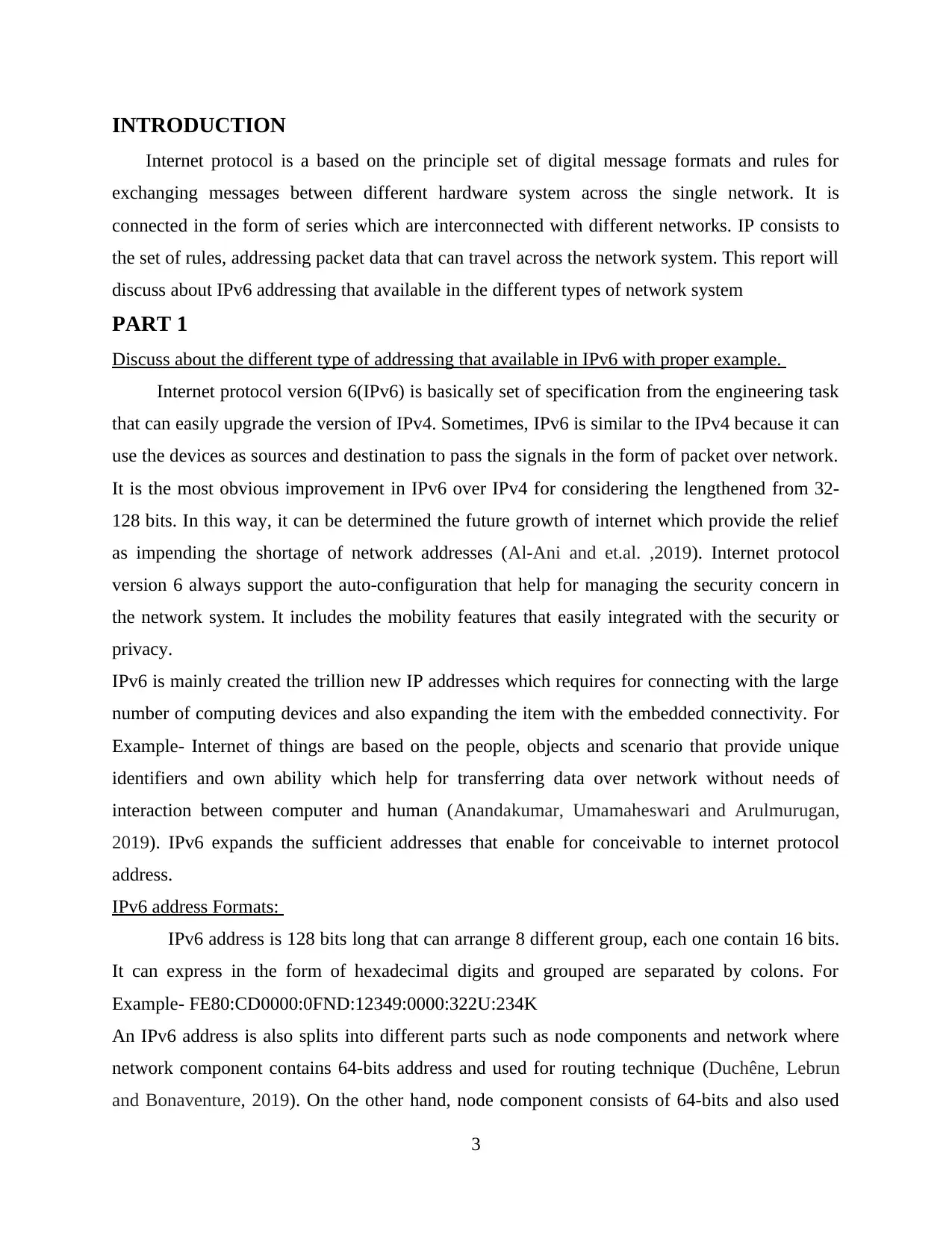
INTRODUCTION
Internet protocol is a based on the principle set of digital message formats and rules for
exchanging messages between different hardware system across the single network. It is
connected in the form of series which are interconnected with different networks. IP consists to
the set of rules, addressing packet data that can travel across the network system. This report will
discuss about IPv6 addressing that available in the different types of network system
PART 1
Discuss about the different type of addressing that available in IPv6 with proper example.
Internet protocol version 6(IPv6) is basically set of specification from the engineering task
that can easily upgrade the version of IPv4. Sometimes, IPv6 is similar to the IPv4 because it can
use the devices as sources and destination to pass the signals in the form of packet over network.
It is the most obvious improvement in IPv6 over IPv4 for considering the lengthened from 32-
128 bits. In this way, it can be determined the future growth of internet which provide the relief
as impending the shortage of network addresses (Al-Ani and et.al. ,2019). Internet protocol
version 6 always support the auto-configuration that help for managing the security concern in
the network system. It includes the mobility features that easily integrated with the security or
privacy.
IPv6 is mainly created the trillion new IP addresses which requires for connecting with the large
number of computing devices and also expanding the item with the embedded connectivity. For
Example- Internet of things are based on the people, objects and scenario that provide unique
identifiers and own ability which help for transferring data over network without needs of
interaction between computer and human (Anandakumar, Umamaheswari and Arulmurugan,
2019). IPv6 expands the sufficient addresses that enable for conceivable to internet protocol
address.
IPv6 address Formats:
IPv6 address is 128 bits long that can arrange 8 different group, each one contain 16 bits.
It can express in the form of hexadecimal digits and grouped are separated by colons. For
Example- FE80:CD0000:0FND:12349:0000:322U:234K
An IPv6 address is also splits into different parts such as node components and network where
network component contains 64-bits address and used for routing technique (Duchêne, Lebrun
and Bonaventure, 2019). On the other hand, node component consists of 64-bits and also used
3
Internet protocol is a based on the principle set of digital message formats and rules for
exchanging messages between different hardware system across the single network. It is
connected in the form of series which are interconnected with different networks. IP consists to
the set of rules, addressing packet data that can travel across the network system. This report will
discuss about IPv6 addressing that available in the different types of network system
PART 1
Discuss about the different type of addressing that available in IPv6 with proper example.
Internet protocol version 6(IPv6) is basically set of specification from the engineering task
that can easily upgrade the version of IPv4. Sometimes, IPv6 is similar to the IPv4 because it can
use the devices as sources and destination to pass the signals in the form of packet over network.
It is the most obvious improvement in IPv6 over IPv4 for considering the lengthened from 32-
128 bits. In this way, it can be determined the future growth of internet which provide the relief
as impending the shortage of network addresses (Al-Ani and et.al. ,2019). Internet protocol
version 6 always support the auto-configuration that help for managing the security concern in
the network system. It includes the mobility features that easily integrated with the security or
privacy.
IPv6 is mainly created the trillion new IP addresses which requires for connecting with the large
number of computing devices and also expanding the item with the embedded connectivity. For
Example- Internet of things are based on the people, objects and scenario that provide unique
identifiers and own ability which help for transferring data over network without needs of
interaction between computer and human (Anandakumar, Umamaheswari and Arulmurugan,
2019). IPv6 expands the sufficient addresses that enable for conceivable to internet protocol
address.
IPv6 address Formats:
IPv6 address is 128 bits long that can arrange 8 different group, each one contain 16 bits.
It can express in the form of hexadecimal digits and grouped are separated by colons. For
Example- FE80:CD0000:0FND:12349:0000:322U:234K
An IPv6 address is also splits into different parts such as node components and network where
network component contains 64-bits address and used for routing technique (Duchêne, Lebrun
and Bonaventure, 2019). On the other hand, node component consists of 64-bits and also used
3
⊘ This is a preview!⊘
Do you want full access?
Subscribe today to unlock all pages.

Trusted by 1+ million students worldwide
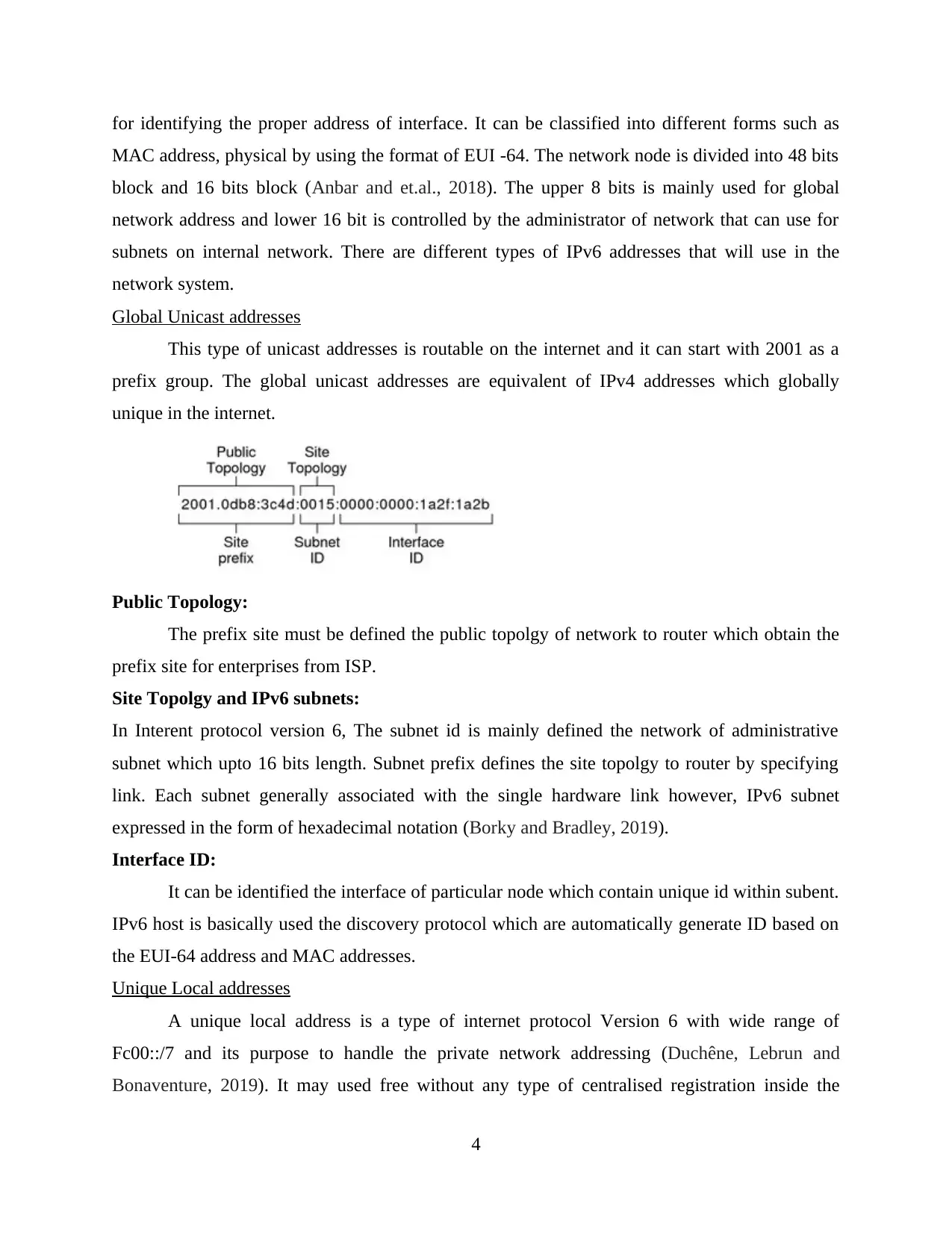
for identifying the proper address of interface. It can be classified into different forms such as
MAC address, physical by using the format of EUI -64. The network node is divided into 48 bits
block and 16 bits block (Anbar and et.al., 2018). The upper 8 bits is mainly used for global
network address and lower 16 bit is controlled by the administrator of network that can use for
subnets on internal network. There are different types of IPv6 addresses that will use in the
network system.
Global Unicast addresses
This type of unicast addresses is routable on the internet and it can start with 2001 as a
prefix group. The global unicast addresses are equivalent of IPv4 addresses which globally
unique in the internet.
Public Topology:
The prefix site must be defined the public topolgy of network to router which obtain the
prefix site for enterprises from ISP.
Site Topolgy and IPv6 subnets:
In Interent protocol version 6, The subnet id is mainly defined the network of administrative
subnet which upto 16 bits length. Subnet prefix defines the site topolgy to router by specifying
link. Each subnet generally associated with the single hardware link however, IPv6 subnet
expressed in the form of hexadecimal notation (Borky and Bradley, 2019).
Interface ID:
It can be identified the interface of particular node which contain unique id within subent.
IPv6 host is basically used the discovery protocol which are automatically generate ID based on
the EUI-64 address and MAC addresses.
Unique Local addresses
A unique local address is a type of internet protocol Version 6 with wide range of
Fc00::/7 and its purpose to handle the private network addressing (Duchêne, Lebrun and
Bonaventure, 2019). It may used free without any type of centralised registration inside the
4
MAC address, physical by using the format of EUI -64. The network node is divided into 48 bits
block and 16 bits block (Anbar and et.al., 2018). The upper 8 bits is mainly used for global
network address and lower 16 bit is controlled by the administrator of network that can use for
subnets on internal network. There are different types of IPv6 addresses that will use in the
network system.
Global Unicast addresses
This type of unicast addresses is routable on the internet and it can start with 2001 as a
prefix group. The global unicast addresses are equivalent of IPv4 addresses which globally
unique in the internet.
Public Topology:
The prefix site must be defined the public topolgy of network to router which obtain the
prefix site for enterprises from ISP.
Site Topolgy and IPv6 subnets:
In Interent protocol version 6, The subnet id is mainly defined the network of administrative
subnet which upto 16 bits length. Subnet prefix defines the site topolgy to router by specifying
link. Each subnet generally associated with the single hardware link however, IPv6 subnet
expressed in the form of hexadecimal notation (Borky and Bradley, 2019).
Interface ID:
It can be identified the interface of particular node which contain unique id within subent.
IPv6 host is basically used the discovery protocol which are automatically generate ID based on
the EUI-64 address and MAC addresses.
Unique Local addresses
A unique local address is a type of internet protocol Version 6 with wide range of
Fc00::/7 and its purpose to handle the private network addressing (Duchêne, Lebrun and
Bonaventure, 2019). It may used free without any type of centralised registration inside the
4
Paraphrase This Document
Need a fresh take? Get an instant paraphrase of this document with our AI Paraphraser
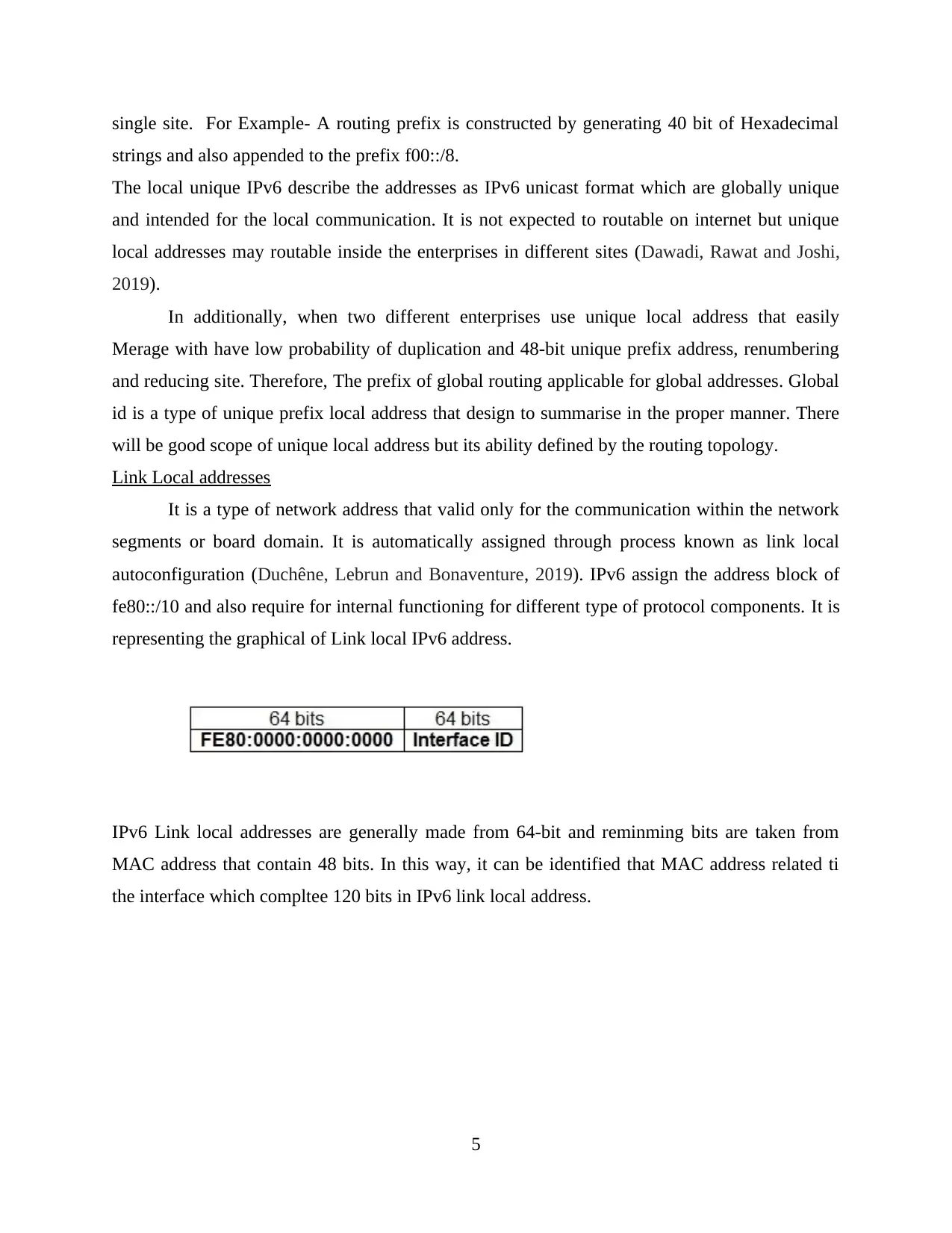
single site. For Example- A routing prefix is constructed by generating 40 bit of Hexadecimal
strings and also appended to the prefix f00::/8.
The local unique IPv6 describe the addresses as IPv6 unicast format which are globally unique
and intended for the local communication. It is not expected to routable on internet but unique
local addresses may routable inside the enterprises in different sites (Dawadi, Rawat and Joshi,
2019).
In additionally, when two different enterprises use unique local address that easily
Merage with have low probability of duplication and 48-bit unique prefix address, renumbering
and reducing site. Therefore, The prefix of global routing applicable for global addresses. Global
id is a type of unique prefix local address that design to summarise in the proper manner. There
will be good scope of unique local address but its ability defined by the routing topology.
Link Local addresses
It is a type of network address that valid only for the communication within the network
segments or board domain. It is automatically assigned through process known as link local
autoconfiguration (Duchêne, Lebrun and Bonaventure, 2019). IPv6 assign the address block of
fe80::/10 and also require for internal functioning for different type of protocol components. It is
representing the graphical of Link local IPv6 address.
IPv6 Link local addresses are generally made from 64-bit and reminming bits are taken from
MAC address that contain 48 bits. In this way, it can be identified that MAC address related ti
the interface which compltee 120 bits in IPv6 link local address.
5
strings and also appended to the prefix f00::/8.
The local unique IPv6 describe the addresses as IPv6 unicast format which are globally unique
and intended for the local communication. It is not expected to routable on internet but unique
local addresses may routable inside the enterprises in different sites (Dawadi, Rawat and Joshi,
2019).
In additionally, when two different enterprises use unique local address that easily
Merage with have low probability of duplication and 48-bit unique prefix address, renumbering
and reducing site. Therefore, The prefix of global routing applicable for global addresses. Global
id is a type of unique prefix local address that design to summarise in the proper manner. There
will be good scope of unique local address but its ability defined by the routing topology.
Link Local addresses
It is a type of network address that valid only for the communication within the network
segments or board domain. It is automatically assigned through process known as link local
autoconfiguration (Duchêne, Lebrun and Bonaventure, 2019). IPv6 assign the address block of
fe80::/10 and also require for internal functioning for different type of protocol components. It is
representing the graphical of Link local IPv6 address.
IPv6 Link local addresses are generally made from 64-bit and reminming bits are taken from
MAC address that contain 48 bits. In this way, it can be identified that MAC address related ti
the interface which compltee 120 bits in IPv6 link local address.
5
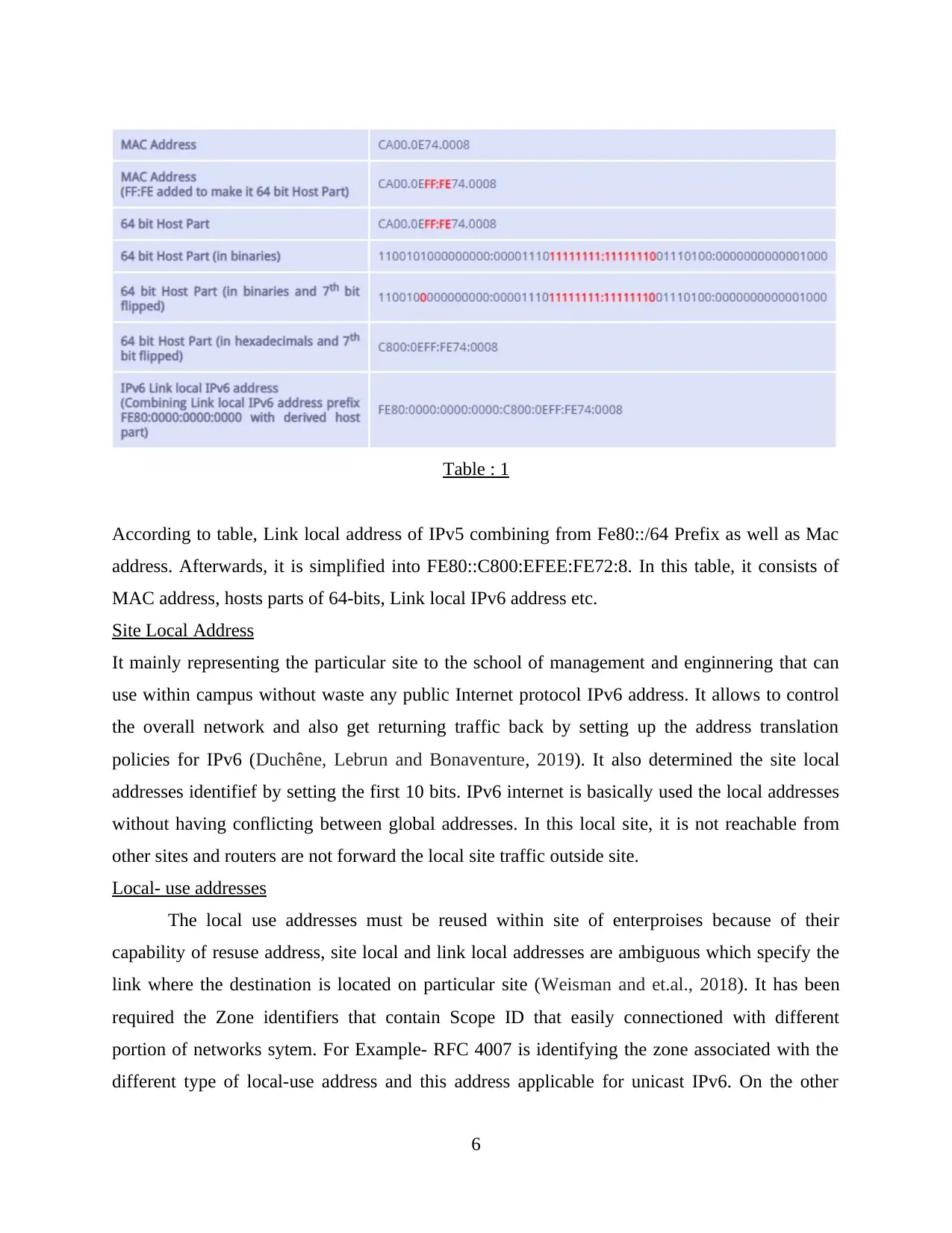
Table : 1
According to table, Link local address of IPv5 combining from Fe80::/64 Prefix as well as Mac
address. Afterwards, it is simplified into FE80::C800:EFEE:FE72:8. In this table, it consists of
MAC address, hosts parts of 64-bits, Link local IPv6 address etc.
Site Local Address
It mainly representing the particular site to the school of management and enginnering that can
use within campus without waste any public Internet protocol IPv6 address. It allows to control
the overall network and also get returning traffic back by setting up the address translation
policies for IPv6 (Duchêne, Lebrun and Bonaventure, 2019). It also determined the site local
addresses identifief by setting the first 10 bits. IPv6 internet is basically used the local addresses
without having conflicting between global addresses. In this local site, it is not reachable from
other sites and routers are not forward the local site traffic outside site.
Local- use addresses
The local use addresses must be reused within site of enterproises because of their
capability of resuse address, site local and link local addresses are ambiguous which specify the
link where the destination is located on particular site (Weisman and et.al., 2018). It has been
required the Zone identifiers that contain Scope ID that easily connectioned with different
portion of networks sytem. For Example- RFC 4007 is identifying the zone associated with the
different type of local-use address and this address applicable for unicast IPv6. On the other
6
According to table, Link local address of IPv5 combining from Fe80::/64 Prefix as well as Mac
address. Afterwards, it is simplified into FE80::C800:EFEE:FE72:8. In this table, it consists of
MAC address, hosts parts of 64-bits, Link local IPv6 address etc.
Site Local Address
It mainly representing the particular site to the school of management and enginnering that can
use within campus without waste any public Internet protocol IPv6 address. It allows to control
the overall network and also get returning traffic back by setting up the address translation
policies for IPv6 (Duchêne, Lebrun and Bonaventure, 2019). It also determined the site local
addresses identifief by setting the first 10 bits. IPv6 internet is basically used the local addresses
without having conflicting between global addresses. In this local site, it is not reachable from
other sites and routers are not forward the local site traffic outside site.
Local- use addresses
The local use addresses must be reused within site of enterproises because of their
capability of resuse address, site local and link local addresses are ambiguous which specify the
link where the destination is located on particular site (Weisman and et.al., 2018). It has been
required the Zone identifiers that contain Scope ID that easily connectioned with different
portion of networks sytem. For Example- RFC 4007 is identifying the zone associated with the
different type of local-use address and this address applicable for unicast IPv6. On the other
6
⊘ This is a preview!⊘
Do you want full access?
Subscribe today to unlock all pages.

Trusted by 1+ million students worldwide
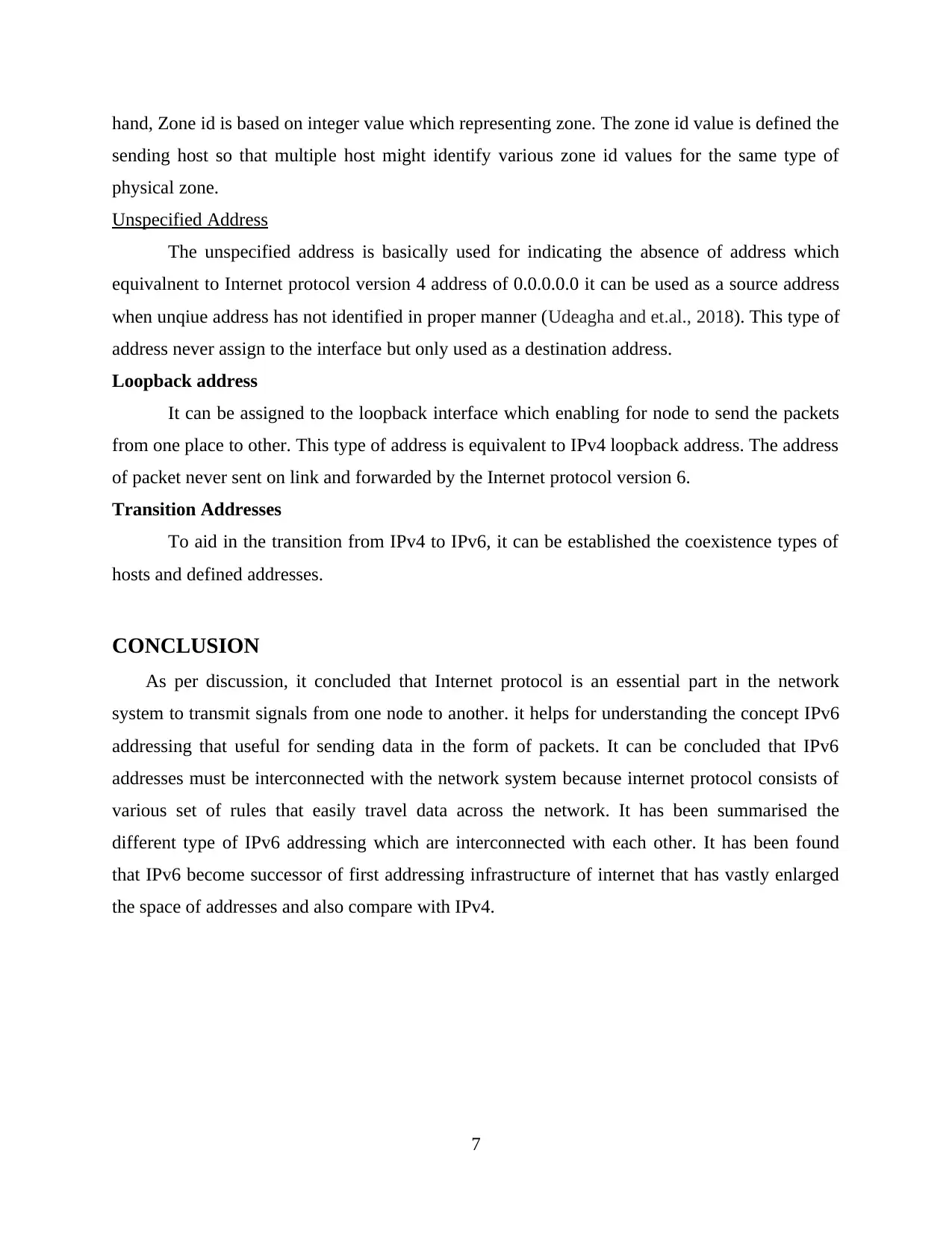
hand, Zone id is based on integer value which representing zone. The zone id value is defined the
sending host so that multiple host might identify various zone id values for the same type of
physical zone.
Unspecified Address
The unspecified address is basically used for indicating the absence of address which
equivalnent to Internet protocol version 4 address of 0.0.0.0.0 it can be used as a source address
when unqiue address has not identified in proper manner (Udeagha and et.al., 2018). This type of
address never assign to the interface but only used as a destination address.
Loopback address
It can be assigned to the loopback interface which enabling for node to send the packets
from one place to other. This type of address is equivalent to IPv4 loopback address. The address
of packet never sent on link and forwarded by the Internet protocol version 6.
Transition Addresses
To aid in the transition from IPv4 to IPv6, it can be established the coexistence types of
hosts and defined addresses.
CONCLUSION
As per discussion, it concluded that Internet protocol is an essential part in the network
system to transmit signals from one node to another. it helps for understanding the concept IPv6
addressing that useful for sending data in the form of packets. It can be concluded that IPv6
addresses must be interconnected with the network system because internet protocol consists of
various set of rules that easily travel data across the network. It has been summarised the
different type of IPv6 addressing which are interconnected with each other. It has been found
that IPv6 become successor of first addressing infrastructure of internet that has vastly enlarged
the space of addresses and also compare with IPv4.
7
sending host so that multiple host might identify various zone id values for the same type of
physical zone.
Unspecified Address
The unspecified address is basically used for indicating the absence of address which
equivalnent to Internet protocol version 4 address of 0.0.0.0.0 it can be used as a source address
when unqiue address has not identified in proper manner (Udeagha and et.al., 2018). This type of
address never assign to the interface but only used as a destination address.
Loopback address
It can be assigned to the loopback interface which enabling for node to send the packets
from one place to other. This type of address is equivalent to IPv4 loopback address. The address
of packet never sent on link and forwarded by the Internet protocol version 6.
Transition Addresses
To aid in the transition from IPv4 to IPv6, it can be established the coexistence types of
hosts and defined addresses.
CONCLUSION
As per discussion, it concluded that Internet protocol is an essential part in the network
system to transmit signals from one node to another. it helps for understanding the concept IPv6
addressing that useful for sending data in the form of packets. It can be concluded that IPv6
addresses must be interconnected with the network system because internet protocol consists of
various set of rules that easily travel data across the network. It has been summarised the
different type of IPv6 addressing which are interconnected with each other. It has been found
that IPv6 become successor of first addressing infrastructure of internet that has vastly enlarged
the space of addresses and also compare with IPv4.
7
Paraphrase This Document
Need a fresh take? Get an instant paraphrase of this document with our AI Paraphraser
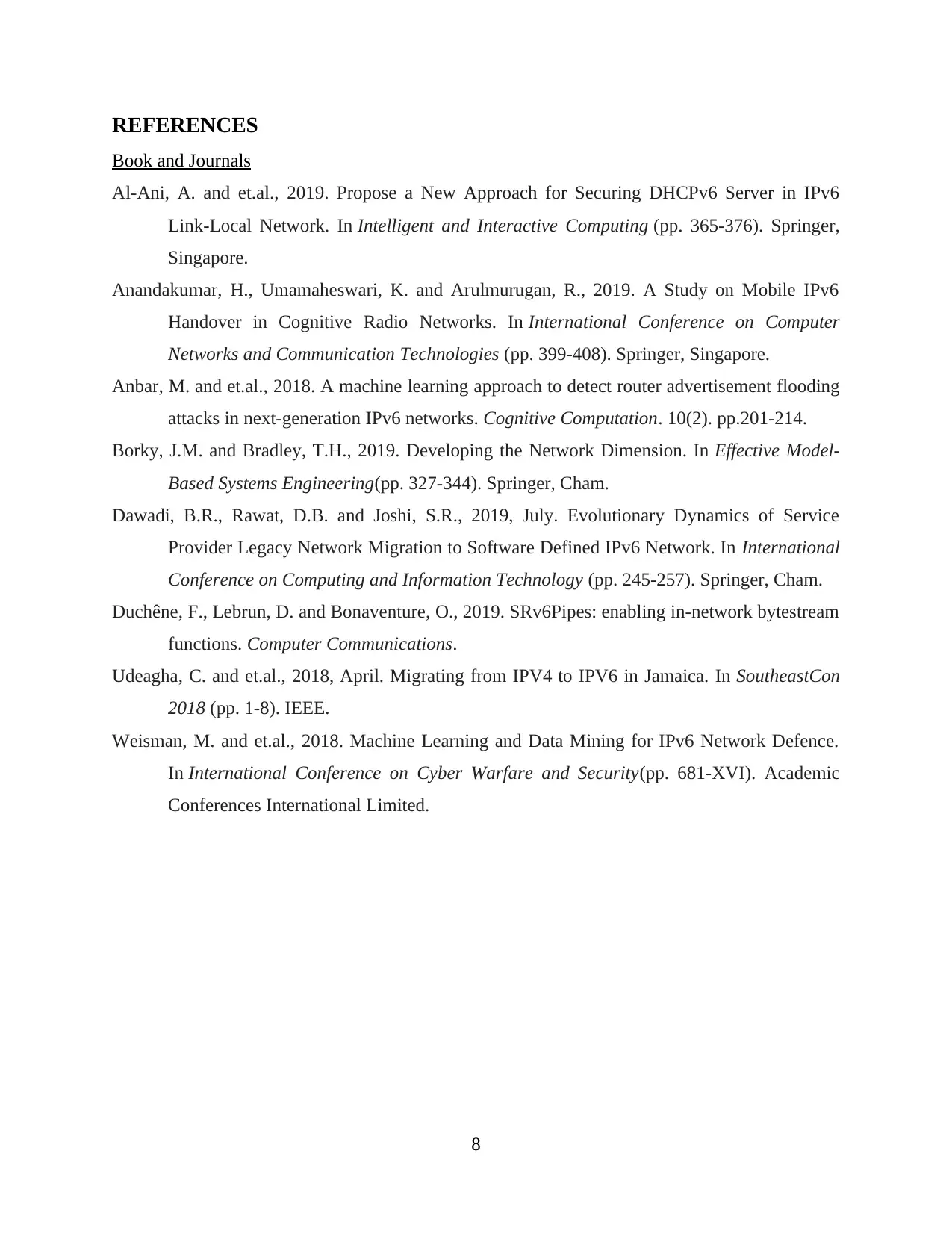
REFERENCES
Book and Journals
Al-Ani, A. and et.al., 2019. Propose a New Approach for Securing DHCPv6 Server in IPv6
Link-Local Network. In Intelligent and Interactive Computing (pp. 365-376). Springer,
Singapore.
Anandakumar, H., Umamaheswari, K. and Arulmurugan, R., 2019. A Study on Mobile IPv6
Handover in Cognitive Radio Networks. In International Conference on Computer
Networks and Communication Technologies (pp. 399-408). Springer, Singapore.
Anbar, M. and et.al., 2018. A machine learning approach to detect router advertisement flooding
attacks in next-generation IPv6 networks. Cognitive Computation. 10(2). pp.201-214.
Borky, J.M. and Bradley, T.H., 2019. Developing the Network Dimension. In Effective Model-
Based Systems Engineering(pp. 327-344). Springer, Cham.
Dawadi, B.R., Rawat, D.B. and Joshi, S.R., 2019, July. Evolutionary Dynamics of Service
Provider Legacy Network Migration to Software Defined IPv6 Network. In International
Conference on Computing and Information Technology (pp. 245-257). Springer, Cham.
Duchêne, F., Lebrun, D. and Bonaventure, O., 2019. SRv6Pipes: enabling in-network bytestream
functions. Computer Communications.
Udeagha, C. and et.al., 2018, April. Migrating from IPV4 to IPV6 in Jamaica. In SoutheastCon
2018 (pp. 1-8). IEEE.
Weisman, M. and et.al., 2018. Machine Learning and Data Mining for IPv6 Network Defence.
In International Conference on Cyber Warfare and Security(pp. 681-XVI). Academic
Conferences International Limited.
8
Book and Journals
Al-Ani, A. and et.al., 2019. Propose a New Approach for Securing DHCPv6 Server in IPv6
Link-Local Network. In Intelligent and Interactive Computing (pp. 365-376). Springer,
Singapore.
Anandakumar, H., Umamaheswari, K. and Arulmurugan, R., 2019. A Study on Mobile IPv6
Handover in Cognitive Radio Networks. In International Conference on Computer
Networks and Communication Technologies (pp. 399-408). Springer, Singapore.
Anbar, M. and et.al., 2018. A machine learning approach to detect router advertisement flooding
attacks in next-generation IPv6 networks. Cognitive Computation. 10(2). pp.201-214.
Borky, J.M. and Bradley, T.H., 2019. Developing the Network Dimension. In Effective Model-
Based Systems Engineering(pp. 327-344). Springer, Cham.
Dawadi, B.R., Rawat, D.B. and Joshi, S.R., 2019, July. Evolutionary Dynamics of Service
Provider Legacy Network Migration to Software Defined IPv6 Network. In International
Conference on Computing and Information Technology (pp. 245-257). Springer, Cham.
Duchêne, F., Lebrun, D. and Bonaventure, O., 2019. SRv6Pipes: enabling in-network bytestream
functions. Computer Communications.
Udeagha, C. and et.al., 2018, April. Migrating from IPV4 to IPV6 in Jamaica. In SoutheastCon
2018 (pp. 1-8). IEEE.
Weisman, M. and et.al., 2018. Machine Learning and Data Mining for IPv6 Network Defence.
In International Conference on Cyber Warfare and Security(pp. 681-XVI). Academic
Conferences International Limited.
8

9
⊘ This is a preview!⊘
Do you want full access?
Subscribe today to unlock all pages.

Trusted by 1+ million students worldwide
1 out of 9
Related Documents
Your All-in-One AI-Powered Toolkit for Academic Success.
+13062052269
info@desklib.com
Available 24*7 on WhatsApp / Email
![[object Object]](/_next/static/media/star-bottom.7253800d.svg)
Unlock your academic potential
Copyright © 2020–2025 A2Z Services. All Rights Reserved. Developed and managed by ZUCOL.


